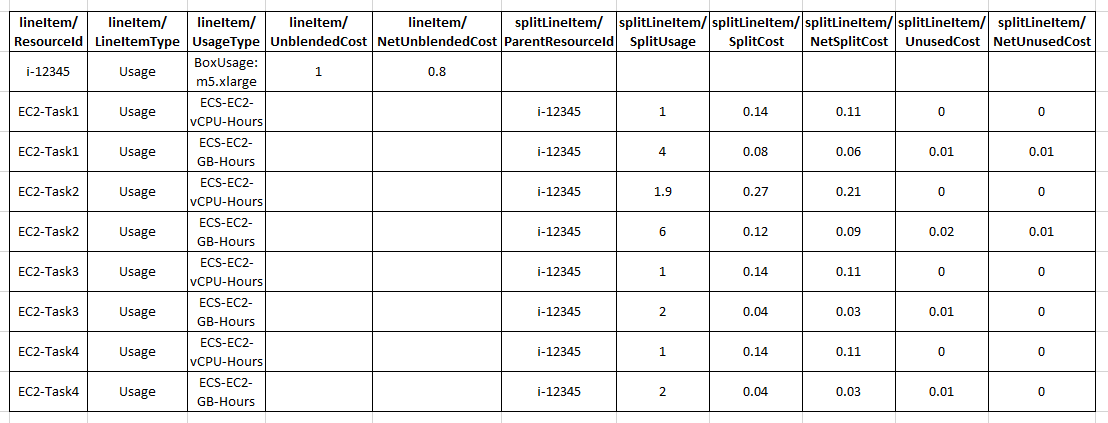Example of split cost allocation data
The purpose of the following example is to show you how split cost allocation data is calculated by computing the cost of individual Amazon ECS services, tasks in Amazon ECS clusters, and Kubernetes namespace and pods in Amazon EKS clusters. The rates used throughout the example are for illustrative purposes only.
Note
The example demonstrates Kubernetes namespace and pods running in Amazon EKS clusters. We can then apply the same cost model to Amazon ECS service and tasks running in a Amazon ECS cluster.
You have the following usage in a single hour:
-
Single instance (m5.xlarge) shared cluster with two namespaces and four pods, running for the duration of a full hour.
-
Instance configuration is 4 vCPU and 16 GB of memory.
-
Amortized cost of the instance is $1/hr.
Split cost allocation data uses relative unit weights for CPU and memory based on
a 9:1 ratio. This is derived from per vCPU per hour and per GB per hour prices in
Amazon Fargate
Step 1: Compute the unit cost for CPU and memory
Unit-cost-per-resource = Hourly-instance-cost/((Memory-weight *
Memory-available) + (CPU-weight * CPU-available))
= $1/( (1 * 16GB) + (9 * 4vCPU)) = $0.02
Cost-per-vCPU-hour = CPU-weight * Unit-cost-per-resource
= 9 * $0.02 = $0.17
Cost-per-GB-hour = Memory-weight * Unit-cost-per-resource
= 1 * $0.02 = $0.02
| Instance | Instance type | vCPU-available | Memory-available | Amortized-cost-per-hour | Cost-per-vCPU-hour | Cost-per-GB-hour |
|---|---|---|---|---|---|---|
| Instance1 | m5.xlarge | 4 | 16 | $1 | $0.17 | $0.02 |
Step 2: Compute the allocated capacity and instance unused capacity
-
Allocated capacity: The memory and vCPU allocated to the Kubernetes pod from the parent EC2 instance, defined as the maximum of used and reserved capacity.
Note
If memory or vCPU usage data is unavailable, reservation data will be used instead. For more information, see Amazon ECS usage reports, or Amazon EKS cost monitoring.
-
Instance unused capacity: The unused capacity of vCPU and memory.
Pod1-Allocated-vCPU = Max (1 vCPU, 0.1 vCPU) = 1 vCPU
Pod1-Allocated-memory = Max (4 GB, 3 GB) = 4 GB
Instance-Unused-vCPU = Max (CPU-available - SUM(Allocated-vCPU),
0) = Max (4 – 4.9, 0) = 0
Instance-Unused-memory = Max (Memory-available - SUM(Allocated-memory),
0) = Max (16 – 14, 0) = 2 GB
In this example, the instance has CPU over subscription, attributed to Pod2 that used more vCPU than what was reserved.
| Pod name | Namespace | Reserved-vCPU | Used-vCPU | Allocated-vCPU | Reserved-memory | Used-memory | Allocated-memory |
|---|---|---|---|---|---|---|---|
| Pod1 | Namespace1 | 1 | 0.1 | 1 | 4 | 3 | 4 |
| Pod2 | Namespace2 | 1 | 1.9 | 1.9 | 4 | 6 | 6 |
| Pod3 | Namespace1 | 1 | 0.5 | 1 | 2 | 2 | 2 |
| Pod4 | Namespace2 | 1 | 0.5 | 1 | 2 | 2 | 2 |
| Unused | Unused | 0 | 2 | ||||
| 4.9 | 16 |
Step 3: Compute the split usage ratios
-
Split usage ratio: The percentage of CPU or memory used by the Kubernetes pod compared to the overall CPU or memory available on the EC2 instance.
-
Unused ratio: The percentage of CPU or memory used by the Kubernetes pod compared to the overall CPU or memory used on the EC2 instance (that is, not factoring in the unused CPU or memory on the instance).
Pod1-vCPU-split-usage-ratio = Allocated-vCPU / Total-vCPU
= 1 vCPU / 4.9vCPU = 0.204
Pod1-Memory-split-usage-ratio = Allocated-GB / Total-GB
= 4 GB/ 16GB = 0.250
Pod1-vCPU-unused-ratio = Pod1-vCPU-split-usage-ratio /
(Total-CPU-split-usage-ratio – Instance-unused-CPU) (set to 0 if
Instance-unused-CPU is 0)
= 0 (since Instance-unused-CPU is 0)
Pod1-Memory-unused-ratio = Pod1-Memory-split-usage-ratio /
(Total-Memory-split-usage-ratio – Instance-unused-memory) (set to 0
if Instance-unused-memory is 0)
= 0.250 / (1-0.125) = 0.286
| Pod name | Namespace | vCPU-split-usage-ratio | vCPU-unused-ratio | Memory-split-usage-ratio | Memory-unused-ratio |
|---|---|---|---|---|---|
| Pod1 | Namespace1 | 0.204 | 0 | 0.250 | 0.286 |
| Pod2 | Namespace2 | 0.388 | 0 | 0.375 | 0.429 |
| Pod3 | Namespace1 | 0.204 | 0 | 0.125 | 0.143 |
| Pod4 | Namespace2 | 0.204 | 0 | 0.125 | 0.143 |
| Unused | Unused | 0 | 0.125 | ||
| 1 | 1 |
Step 4: Compute the split cost and unused costs
-
Split cost: The pay per use cost allocation of the EC2 instance cost based on allocated CPU and memory usage by the Kubernetes pod.
-
Unused instance cost: The cost of unused CPU or memory resources on the instance.
Pod1-Split-cost = (Pod1-vCPU-split-usage-ratio * vCPU-available *
Cost-per-vCPU-hour) + (Pod1-Memory-split-usage-ratio * Memory-available *
Cost-per-GB-hour)
= (0.204 * 4 vCPU * $0.17) + (0.25 * 16GB * $0.02) = $0.22
Pod1-Unused-cost = (Pod1-vCPU-unused-ratio *
Instance-vCPU-unused-ratio * vCPU-available * Cost-per-VCPU-hour) +
(Pod1-Memory-unused-ratio * Instance-Memory-unused ratio * Memory-available
* Cost-per-GB-hour)
= (0 * 0 * 4 * $0.17) + (0.286 * 0.125 * 16 * $0.02) = $0.01
Pod1-Total-split-cost = Pod1-Split-cost +
Pod1-Unused-cost
= $0.23
| Pod name | Namespace | Split-cost | Unused-cost | Total-split-cost |
|---|---|---|---|---|
| Pod1 | Namespace1 | $0.22 | $0.01 | $0.23 |
| Pod2 | Namespace2 | $0.38 | $0.02 | $0.40 |
| Pod3 | Namespace1 | $0.18 | $0.01 | $0.19 |
| Pod4 | Namespace2 | $0.18 | $0.01 | $0.19 |
| Unused | Unused | $0.04 | ||
| $1 | $0.04 | $1 |
The cost of the service is the sum of the cost of pods associated with each namespace.
Total cost of Namespace1 = $0.23 + $0.19 = $0.42
Total cost of Namespace2 = $0.40 + $0.19 = $0.59
Sample Amazon CUR
If you have an Amazon EC2 instance running at On-Demand rates, then the cost of the instance is computed using lineItem/UnblendedCost.
